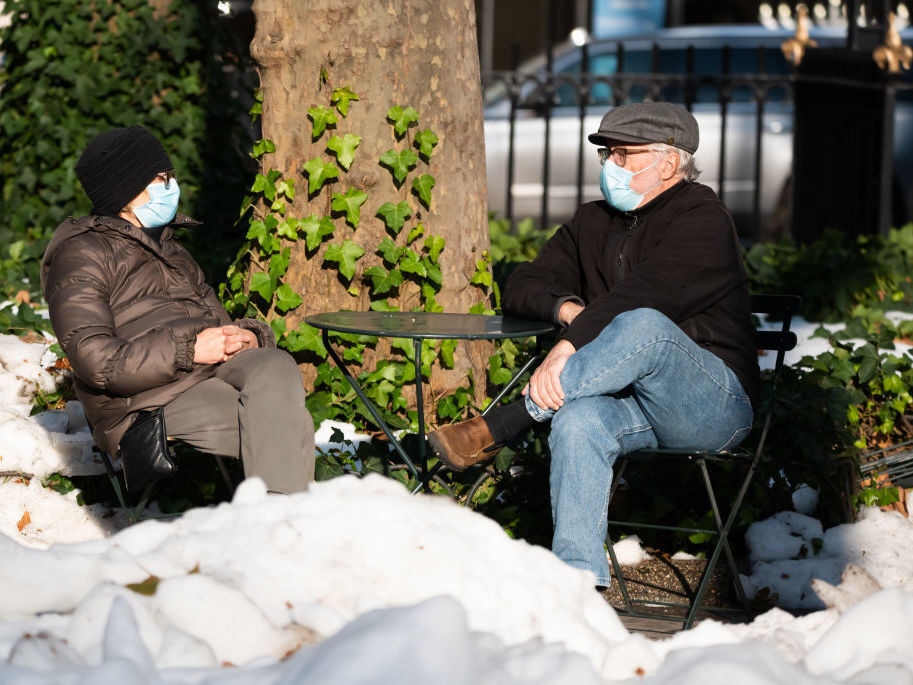
Mask-wearing and social distancing are up in the United States, a survey finds.
Noam Galai/Getty Images
hide caption
toggle caption
Noam Galai/Getty Images

Mask-wearing and social distancing are up in the United States, a survey finds.
Noam Galai/Getty Images
Americans are being more careful to avoid catching and spreading the coronavirus but are still not being careful enough to slow the pandemic, especially with worrisome, apparently more contagious new variants looming.
That’s the conclusion of the latest findings, released Friday, from the largest national survey tracking behavior during the coronavirus pandemic.
“It’s good news-bad news,” says David Lazer of Northeastern University, who is helping run the survey with colleagues at Harvard, Rutgers and Northwestern universities.
“The good news is we’ve improved a lot in terms of mask-wearing and social distancing. The bad news is, to bend the curve they really need to be much better,” Lazer says.
Lazer’s consortium has been surveying about 20,000 people in all 50 U.S. states plus the District of Columbia since last spring. The latest data come from 25,640 people who were surveyed Dec. 16 and Jan. 11.
Mask-wearing reached an all-time high of about 80%, the survey found. In addition, a wide range of other behaviors also improved. For example, there were declines in the percentages of people saying that in the past 24 hours they went to work, the gym or a restaurant or spent time in crowded places or a room with people outside their household.
The trends are encouraging, especially because many social distancing behaviors had decreased between the spring and the fall, which likely helped fuel the surge that’s currently underway, Lazer says.
But aside from mask-wearing, all the other precautionary behaviors still remain less common than in the spring, the survey shows. And some precautions actually declined, such as frequent hand-washing.
“Clearly this is not enough to keep COVID-19 from spreading,” Lazer says.
Others agree.
“It was a bit startling to see how many people spent time indoors with someone outside their household,” Saskia Popescu, an epidemiologist at the University of Arizona, told NPR via email.
As we wait for widespread vaccination to take place, precautionary behaviors are still vitally important, says Dr. Benjamin Linas, an associate professor of epidemiology at Boston University.
“This is a critical moment,” he says. “We are in a race between the virus and our pace of vaccination.”
Those concerns are being magnified by the emergence of the new, more contagious strains.
“We have uncontrolled spread of COVID in most of the country, and there is a reasonably high likelihood that the new, more infectious strain from the United Kingdom or other highly infectious strains may gain a foothold here and make a really bad situation even worse,” says Dr. Thomas Frieden, a former director of the Centers for Disease Control and Prevention.
“We need to not just do more of the same. We need to do better of the same,” he adds.
The survey results come during the worst period since the pandemic began. More than 200,000 people are getting infected every day in the U.S., and more than 4,000 deaths are being reported on some days. Hospitalizations are at record highs.
The current surge was probably intensified by people traveling and gathering for the Thanksgiving, Christmas and New Year’s holidays, several experts told NPR.
A second report from the survey finds that support for new measures to curb the virus’s spread is high nationwide. That includes asking people to stay home and avoid gatherings, requiring most businesses to close, canceling major sports and entertainment events, limiting restaurants to carry-out only, restricting international and domestic travel and prohibiting K-12 teaching in person.
“We found remarkably strong support across the board for increasingly strong measures,” Lazer says.
At least in some states, the very worst of the current surge may be over, according to a high-profile research group at the University of Washington in Seattle. The group released new projections for the pandemic on Thursday. The pandemic has probably peaked in 23 states and will likely peak nationally by the end of the month, the group says.
But a total of 566,720 people could die from the pandemic by May 1 unless greater efforts are made to slow the virus’s spread, the group estimates. While that’s slightly lower than the group’s previous projection, researchers say even more lives could be saved if more people took precautions.
“Definitely we need to do much better, and we can do much better,” says Ali Mokdad of the Institute for Health Metrics and Evaluation.
“The behaviors that we have right now are not good enough. We still need to do better in order to bring this virus down much faster.”